Monday, 23 February 2015 21:59
by ENE News
“Strontium-90 Levels Spike Alarmingly”- Multiple Alarms Set Off at Fukushima Plant
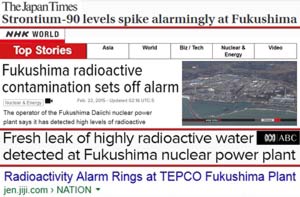 AFP, Feb 22, 2015 (emphasis added): Sensors at the Fukushima nuclear plant have detected a fresh leak of highly radioactive water into the sea… [with] contamination levels up to 70 times greater than the already-high radioactive status seen at the plant… TEPCO said its emergency inspections of tanks storing nuclear waste water did not find any additional abnormalities… It was not immediately clear what caused the original spike… “With emergency surveys of the plant and monitoring of other sensors, we have no reason to believe tanks storing radioactive waste water have leaked… We are currently monitoring the sensors”… The latest incident, one of several that have plagued the plant in recent months, reflects the difficulty in controlling and decommissioning the plant… TEPCO has not been able to effectively deal with an increasing amount of contaminated water… AFP, Feb 22, 2015 (emphasis added): Sensors at the Fukushima nuclear plant have detected a fresh leak of highly radioactive water into the sea… [with] contamination levels up to 70 times greater than the already-high radioactive status seen at the plant… TEPCO said its emergency inspections of tanks storing nuclear waste water did not find any additional abnormalities… It was not immediately clear what caused the original spike… “With emergency surveys of the plant and monitoring of other sensors, we have no reason to believe tanks storing radioactive waste water have leaked… We are currently monitoring the sensors”… The latest incident, one of several that have plagued the plant in recent months, reflects the difficulty in controlling and decommissioning the plant… TEPCO has not been able to effectively deal with an increasing amount of contaminated water…
Read more...
Sunday, 07 September 2014 16:06
by Ralph Nader
Taxpayer-Guaranteed
 The Nuclear Energy Institute (NEI) – the corporate lobbyist in Washington, D.C. for the disintegrating atomic power industry – doesn’t have to worry about repercussions from the negative impacts of nuclear power. For nuclear power is a government/taxpayer-guaranteed boondoggle whose staggering costs, incurred and deferred, are absorbed by American taxpayers via a supine government regulatory and subsidy apparatus. The Nuclear Energy Institute (NEI) – the corporate lobbyist in Washington, D.C. for the disintegrating atomic power industry – doesn’t have to worry about repercussions from the negative impacts of nuclear power. For nuclear power is a government/taxpayer-guaranteed boondoggle whose staggering costs, incurred and deferred, are absorbed by American taxpayers via a supine government regulatory and subsidy apparatus.
So if you go to work at the NEI and you read about the absence of any permanent radioactive waste storage site, no problem, the government/taxpayers are responsible for transporting and safeguarding that lethal garbage for centuries.
Read more...
Wednesday, 19 February 2014 22:24
By Kyle Cleveland
“Most Significant Public Health Crisis in Modern World History”
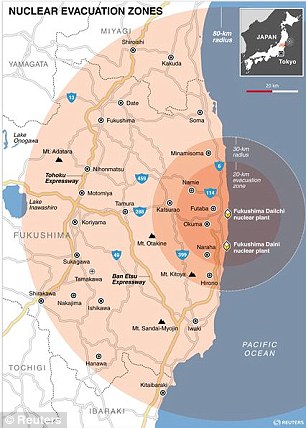 The nuclear disaster in Fukushima which followed in the wake of the 3/11 Tohoku earthquake and tsunami has given rise to one of the most significant public health crises in modern world history, with profound implications for how nuclear energy is perceived. This paper analyzes the most dire phase of the Fukushima nuclear crisis, showing how the level of risk was assessed by nuclear experts and state-level actors who worked largely out of view of public scrutiny. In addition to examining how the accident progression in the reactors was addressed and conveyed to the general public, the paper addresses how the exclusionary zones were determined by Japanese and foreign governments in Japan. The nuclear disaster in Fukushima which followed in the wake of the 3/11 Tohoku earthquake and tsunami has given rise to one of the most significant public health crises in modern world history, with profound implications for how nuclear energy is perceived. This paper analyzes the most dire phase of the Fukushima nuclear crisis, showing how the level of risk was assessed by nuclear experts and state-level actors who worked largely out of view of public scrutiny. In addition to examining how the accident progression in the reactors was addressed and conveyed to the general public, the paper addresses how the exclusionary zones were determined by Japanese and foreign governments in Japan.
Read more...
Wednesday, 19 February 2014 22:07
by Ingmar Schumacher
 The European Commission is assessing how it should augment its nuclear disaster insurance. Ingmar Schumacher calls for full transparency of insurance costs in the cost-benefit evaluation of the nuclear industry. The European Commission is assessing how it should augment its nuclear disaster insurance. Ingmar Schumacher calls for full transparency of insurance costs in the cost-benefit evaluation of the nuclear industry.
The continuing nuclear disaster at Fukushima has concentrated minds on the risks of nuclear catastrope in Europe - all the more so as estimates of Fukushima's cost rise towards a giddying US$500 billion.
And so it is that the European Commission is considering whether, and how, it should amend the insurance of nuclear power plants on European territory. In the event of the unthinkable taking place in a European reactor, who will pay the cost?
Read more...
Tuesday, 29 October 2013 19:50
By Ethan A. Huff
Fukushima Radiation is Tearing up the West Coast of the US and Canada
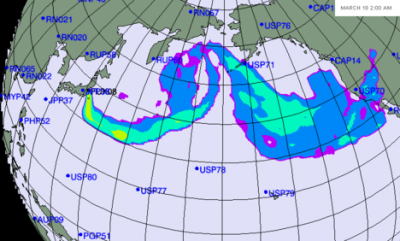 As cleanup crews gear themselves up to begin the treacherous task of removing 400 tons of spent fuel from the Fukushima Daiichi Reactor No. 4 in the coming weeks, reports continue to flood in showing that radiation from the stricken plant is still causing major environmental damage all over the world. As cleanup crews gear themselves up to begin the treacherous task of removing 400 tons of spent fuel from the Fukushima Daiichi Reactor No. 4 in the coming weeks, reports continue to flood in showing that radiation from the stricken plant is still causing major environmental damage all over the world.
Particularly on the West Coast of the U.S., a multitude of strange animal deaths, high radiation readings and other recent anomalies suggest that the Fukushima disaster is far from over. It is simply ludicrous, in other words, for anyone to suggest at this point that these Fukushima woes are dwindling, as fresh evidence suggests that quite the opposite is true.
Read more...
Saturday, 21 September 2013 07:27
By Harvey Wasserman
Fukushima Fuel Pool at Unit 4. “This is an Issue of Human Survival.”
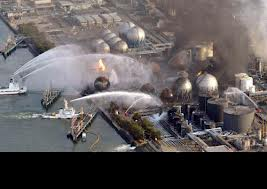 We are now within two months of what may be humankind’s most dangerous moment since the Cuban Missile Crisis. We are now within two months of what may be humankind’s most dangerous moment since the Cuban Missile Crisis.
There is no excuse for not acting. All the resources our species can muster must be focussed on the fuel pool at Fukushima Unit 4.
Fukushima’s owner, Tokyo Electric (Tepco), says that within as few as 60 days it may begin trying to remove more than 1300 spent fuel rods from a badly damaged pool perched 100 feet in the air. The pool rests on a badly damaged building that is tilting, sinking and could easily come down in the next earthquake, if not on its own.
Some 400 tons of fuel in that pool could spew out more than 15,000 times as much radiation as was released at Hiroshima.
Read more...
Sunday, 07 July 2013 20:45
By Michael Leonardi
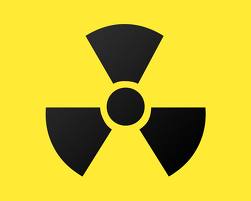 July 1 marks Canada Day when many Canadians celebrate the unification of three colonies into their country on the same date in 1867. July 1 marks Canada Day when many Canadians celebrate the unification of three colonies into their country on the same date in 1867.
In Ontario, droves of people head off to their summer cottages and vacation get-a-ways on the shores of the Great Lakes for the holiday weekend. Lake Huron’s sandy beaches and beautiful aquamarine waters attract many visitors from all over the world. But this year, many First Nations were not celebrating the stripping of their sovereignty rights and desecration of their lands.
Those heading to the Saugeen Shores area and the town of Southampton this past weekend were greeted Saturday by the second annual “Walk the Talk” peaceful protest march against not one, but two permanent underground nuclear dumps less than a mile away from Lake Huron.
Read more...
Tuesday, 11 June 2013 22:27
by Kevin Zeese JD and Margaret Flowers MD
Uranium Mining is Poisoning the Bread Basket of the World
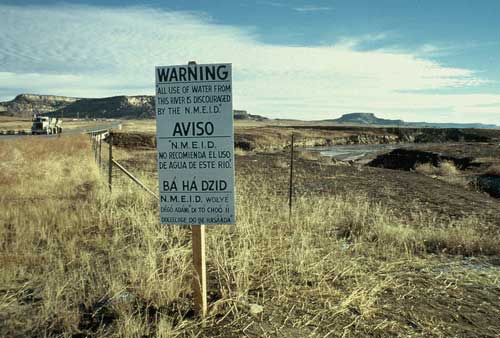 Early in the morning of July 16, 1979, a 20-foot section of the earthen dam blocking the waste pool for the Church Rock Uranium Mill caved in and released 95 million gallons of highly acidic fluid containing 1,100 tons of radioactive material. The fluid and waste flowed into the nearby Puerco River, traveling 80 miles downstream, leaving toxic puddles and backing up local sewers along the way. Early in the morning of July 16, 1979, a 20-foot section of the earthen dam blocking the waste pool for the Church Rock Uranium Mill caved in and released 95 million gallons of highly acidic fluid containing 1,100 tons of radioactive material. The fluid and waste flowed into the nearby Puerco River, traveling 80 miles downstream, leaving toxic puddles and backing up local sewers along the way.
Read more...
|
Wednesday, 01 May 2013 15:16
by Public Employees for Environmental Responsibility (PEER)
Civilian Cancer Deaths Expected to Skyrocket
Rollback in Nuclear Radiation Cleanup

The White House has given final approval for dramatically raising permissible radioactive levels in drinking water and soil following “radiological incidents,” such as nuclear power-plant accidents and dirty bombs. The final version, slated for Federal Register publication as soon as today, is a win for the nuclear industry which seeks what its proponents call a “new normal” for radiation exposure among the U.S population, according Public Employees for Environmental Responsibility (PEER).
Issued by the Environmental Protection Agency, the radiation guides (called Protective Action Guides or PAGs) allow cleanup many times more lax than anything EPA has ever before accepted.
Read more...
Sunday, 28 April 2013 09:34
By Stephen Lendman
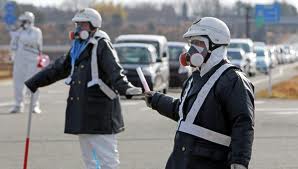 In her book titled “No Immediate Danger: Prognosis for a Radioactive Earth,” nuclear power/environmental health expert Rosalie Bertell (1929 – 2012) said: In her book titled “No Immediate Danger: Prognosis for a Radioactive Earth,” nuclear power/environmental health expert Rosalie Bertell (1929 – 2012) said:
“Should the public discover the true health cost(s) of nuclear pollution, a cry would rise from all parts of the world and people would refuse to cooperate passively with their own death.”
Read more...
Wednesday, 10 April 2013 14:37
By Washington's Blog
Nuclear Plants Should Be Phased Out -
“Can’t Guarantee Against Accident Causing Widespread Land Contamination”
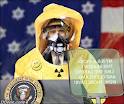 Nuclear Regulators Just “Rolling the Dice” Nuclear Regulators Just “Rolling the Dice”
Energy intelligence reports:
Former Nuclear Regulatory Commission (NRC) Chairman Gregory Jaczko says that the current fleet of operating plants in the US should be phased out because regulators can’t guarantee against an accident causing widespread land contamination. In two key decisions last week Jaczko said the agency “damaged significantly” its international reputation for upholding safety and he accused the five commissioners of “just rolling the dice” in dealing with severe accidents.
Read more...
Wednesday, 24 October 2012 22:10
by Washington's Blog
Unit 4 Is Sinking … Unevenly...And It May Be Tilting!
 The spent fuel pool at Fukushima Unit 4 is the top short-term threat to humanity, and is a national security issue for America. The spent fuel pool at Fukushima Unit 4 is the top short-term threat to humanity, and is a national security issue for America.
As such, it is disturbing news that the ground beneath unit 4 is sinking.
Specifically, Unit 4 sunk 36 inches right after the earthquake, and has sunk another 30 inches since then.
Moreover, Unit 4 is sinking unevenly, and the building may begin tilting.
Read more...
Sunday, 14 October 2012 20:43
By Global Research News
Radiation level spiked in Hokkaido, “Still it’s on-going”
According to the report of Ministry of Education, Culture, Sports, Science and Technology, radiation level spiked up in Hokkaido, the most northern island in Japan.
It started picking up at 15:40 of 10/14/2012 (JST), and still it’s on-going.
* * *

Source
Read more...
Sunday, 07 October 2012 22:00
by Washington's Blog
Containing Fukushima Is Beyond Current Technology,
say Top Nuclear Experts
 World-renowned physicist Michio Kaku said recently: It will take years to invent a new generation of robots able to withstand the radiation. World-renowned physicist Michio Kaku said recently: It will take years to invent a new generation of robots able to withstand the radiation.
(The radiation inside the reactors is too hot even for robots.)
Read more...
Thursday, 27 September 2012 23:05
by David Suzuki Foundation
 Nuclear power is experiencing a revival due to growing concerns about climate change. The nuclear industry has reinvented itself as an environmentally friendly option, producing electricity without the air pollution and greenhouse gas emissions of coal, oil or gas. Nuclear power is experiencing a revival due to growing concerns about climate change. The nuclear industry has reinvented itself as an environmentally friendly option, producing electricity without the air pollution and greenhouse gas emissions of coal, oil or gas.
But a closer look reveals nuclear power is neither an environmentally or financially viable option. Nuclear power creates radioactive waste for which there is no accepted method of safely managing or storing. It is also prohibitively expensive. The last plant constructed in Ontario, Darlington, was budgeted at $3.4 billion but ended up costing $15 billion when it was finally completed in the mid-1980s.
Read more...
Monday, 17 September 2012 22:09
By David Swanson
 President Jimmy Carter’s National Security Advisor was about to wake him up in the middle of the night to inform the President that 220 Soviet nuclear missiles were headed our way, when he learned that someone had stuck a game tape into the computer by mistake. President Jimmy Carter’s National Security Advisor was about to wake him up in the middle of the night to inform the President that 220 Soviet nuclear missiles were headed our way, when he learned that someone had stuck a game tape into the computer by mistake.
Three years later a Soviet Lieutenant Colonel acted out the same scene, with the computer glitch on his side this time. Then in 1984 another U.S. computer glitch led to the quick decision to park an armored car on top of a missile silo to prevent the start of the apocalypse. And again in 1995, the Soviet Union almost responded to a U.S. nuclear attack that proved to be a real missile, but one with a weather satellite rather than a nuke. One Pentagon report documents 563 nuclear mistakes, malfunctions, and false alarms over the years — so far.
Read more...
Wednesday, 30 May 2012 19:55
by Washington's Blog
We noted more than a year ago:
The ocean currents head from Japan to the West Coast of the U.S.
***
Of course, fish don’t necessarily stay still, either. For example, the Telegraph notes that scientists tagged a bluefin tuna and found that it crossed between Japan and the West Coast three times in 600 days:
That might be extreme, but the point is that fish exposed to radiation
somewhere out in the ocean might end up in U.S. waters.
Low levels of radioactive cesium from Japan’s Fukushima Daiichi nuclear
accident turned up in fish caught off California in 2011, researchers reported
Monday.
The bluefin spawn off Japan, and many migrate across the Pacific Ocean.
Tissue samples taken from 15 bluefin caught in August, five months after the
meltdowns at Fukushima Daiichi, all contained reactor byproducts
cesium-134 and cesium-137 at levels that produced radiation about 3%
higher than natural background sources
The Wall Street Journal quotes the studies’ authors:
“The tuna packaged it up and brought it across the world’s largest ocean,”
said marine ecologist Daniel Madigan at Stanford University, who led the study
team. “We were definitely surprised to see it at all and even more surprised to
see it in every one we measured.”
***
“We found that absolutely every one of them had comparable concentrations of
cesium-134 and cesium-137,” said marine biologist Nicholas Fisher at Stony Brook
University in New York state, who was part of the study group.
The bad news is that is is only going to get worse.
Unlike some other compounds, radioactive cesium does not quickly sink to the
sea bottom but remains dispersed in the water column, from the surface to the
ocean floor.
Fish can swim right through it, ingesting it through their gills, by taking
in seawater or by eating organisms that have already taken it in
….
As CNN notes:
Neither [of the scientists who tested the fish] thought they were likely to
find cesium at all, they said. And since the fish tested were born about a year
before the disaster, “This year’s fish are going to be really interesting,”
Madigan said.
“There were fish born around the time of the accident, and those are the ones
showing up in California right now,” he said. “Those have been, for the most
part, swimming around in those contaminated waters their whole
lives.”
In other words, the 15 fish tested were only exposed the radiation for a
short time. But bluefin arriving in California now will have been exposed to the
Fukushima radiation for much longer.
The real test of how radioactivity affects tuna populations comes this summer
when researchers planned to repeat the study with a larger number of samples.
Bluefin tuna that journeyed last year were exposed to radiation for about a
month. The upcoming travelers have been swimming in radioactive
waters for a longer period. How this will affect concentrations of contamination
remains to be seen.
One of the studies’ authors told the BBC:
The fish that will be arriving around now, and in the coming months, to
California waters may be carrying considerably more radioactivity and if
so they may possibly be a public health hazard.
California Fish Contaminated with Fukushima Radiation
“Absolutely Every One” – 15 Out of 15 – Bluefin Tuna Tested In California Waters Contaminated with Fukushima Radiation
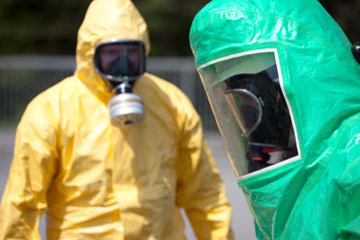 We noted more than a year ago: We noted more than a year ago:
The ocean currents head from Japan to the West Coast of the U.S.
Of course, fish don’t necessarily stay still, either. For example, the Telegraph notes that scientists tagged a bluefin tuna and found that it crossed between Japan and the West Coast three times in 600 days:
That might be extreme, but the point is that fish exposed to radiation somewhere out in the ocean might end up in U.S. waters.
Read more...
Monday, 09 April 2012 10:01
by Washington's Blog
The Fuel Pools of Fukushima
The Greatest Single Threat to Humanity: Fuel Pool Number 4
 We noted days after the Japanese earthquake that the biggest threat was from the spent fuel rods in the fuel pool at Fukushima unit number 4, and not from the reactors themselves. See this and this. We noted days after the Japanese earthquake that the biggest threat was from the spent fuel rods in the fuel pool at Fukushima unit number 4, and not from the reactors themselves. See this and this.
We noted in February:
Scientists say that there is a 70% chance of a magnitude 7.0 earthquake hitting Fukushima this year, and a 98% chance within the next 3 years.
Given that nuclear expert Arnie Gundersen says that an earthquake of 7.0 or larger could cause the entire fuel pool structure collapse, it is urgent that everything humanly possible is done to stabilize the structure housing the fuel pools at reactor number 4.
Tepco is doing some construction at the building … it is a race against time under very difficult circumstances, and hopefully Tepco will win.
Read more...
Friday, 30 March 2012 19:32
by Washington's Blog
Fukushima Radiation Plume Hit Southern and Central California
 The Journal Environmental Science and Technology reports in a new study that the Fukushima radiation plume contacted North America at California “with greatest exposure in central and southern California”, and that Southern California had 2,500 Bq/kg of iodine-131 in seaweed … over 500% higher than other tests in the U.S. and Canada: The Journal Environmental Science and Technology reports in a new study that the Fukushima radiation plume contacted North America at California “with greatest exposure in central and southern California”, and that Southern California had 2,500 Bq/kg of iodine-131 in seaweed … over 500% higher than other tests in the U.S. and Canada:
Projected paths of the radioactive atmospheric plume emanating from the Fukushima reactors, best described as airborne particles or aerosols for 131I, 137Cs, and 35S, and subsequent atmospheric monitoring showed it coming in contact with the North American continent at California, with greatest exposure in central and southern California. Government monitoring sites in Anaheim (southern California) recorded peak airborne concentrations of 131I at 1.9 pCi m?3
Anaheim is where Disneyland is located.
Read more...
Wednesday, 25 January 2012 20:32
by Prof. Michel Chossudovsky
The Unspoken Crisis of Worldwide Nuclear Radiation
ONLINE READER
Note to Readers: Remember to bookmark this page for future reference.
Please Forward the GR I-Book far and wide. Post it on Facebook.
[scroll down for I-BOOK Table of Contents]
 Introduction Introduction
The World is at a critical crossroads. The Fukushima disaster in Japan has brought to the forefront the dangers of Worldwide nuclear radiation.
The crisis in Japan has been described as "a nuclear war without a war". In the words of renowned novelist Haruki Murakami: "This time no one dropped a bomb on us ... We set the stage, we committed the crime with our own hands, we are destroying our own lands, and we are destroying our own lives."
Read more...
Tuesday, 17 January 2012 20:03
by Washington's Blog
California, Finland, Canada, Australia Hit By Radiation
 The University of California at Berkeley detected cesium levels in San Francisco area milk above over EPA limits … and even higher than they were 6 months ago. The University of California at Berkeley detected cesium levels in San Francisco area milk above over EPA limits … and even higher than they were 6 months ago.
Finnish public television says that cesium from Fukushima has been detected in lichens, fungi and elk and reindeer meat in Finland.
The Australian Radiation Protection and Nuclear Safety Agency confirmed a radiation cloud over the East Coast of Australia.
The West Coast of Canada is getting hit by debris from Japan … and at least some of it is likely radioactive.
Read more...
Thursday, 05 January 2012 08:24
by Friends of the Earth Scotland
"Nuclear power is no solution to climate change: exposing the myths"
"A clever man solves a problem; a wise man avoids it." Einstein
 Nuclear-Nuclear: Exposing the myths Nuclear-Nuclear: Exposing the myths
The nuclear industry is hoping that concern over climate change will result in support for nuclear power. However, even solely on the grounds of economic criteria it offers poor value for money in displacing fossil fuel plant. Further, with its high cost, long construction time, high environmental risk and problems resulting from waste management, it is clear that nuclear power does not offer a viable solution to climate change. Rather a mixture of energy efficiency and renewable energy offers a quicker, more realistic and sustainable approach to reducing CO2 emissions.
Exposing the myths 1: Nuclear power is economical and cost effective
Read more...
Friday, 23 December 2011 16:54
by Washington's Blog
“Nuclear Can Be Safe Or It Can Be Cheap … But It Can’t Be Both”
 Nuclear engineer Arnie Gundersen was said in a recent interview that nuclear power can be made safe, but not at a competitive price: Nuclear engineer Arnie Gundersen was said in a recent interview that nuclear power can be made safe, but not at a competitive price:
[Interviewer] With air transport, it’s incredibly safe. Could nuclear power ever reach that level of safety?
[Gundersen] I have a friend who says that nuclear can be safe or it can be cheap, but it can’t be both.
***
It boils down to money. If you want to make nuclear safe, it gets to the point where it’s so costly you don’t want to build the power plant anyway … especially now with plummeting renewable costs.
Read more...
Sunday, 26 June 2011 08:01
by Patrick Henningsen
Since flooding began on June 6th, there has been a disturbingly low level of media attention given to the crisis at the Fort Calhoun Nuclear Facility near Omaha, Nebraska. But evidence strongly suggests that something very serious has in fact happened there.
On June 7th, there was a fire reported at Fort Calhoun. The official story is that the fire was in an electrical switchgear room at the plant. The apparently facility lost power to a pump that cools the spent fuel rod pool, allegedly for a duration of approximately 90 minutes.
Since flooding began on June 6th, there has been a disturbingly
low level of media attention given to the crisis at the Fort Calhoun Nuclear
Facility near Omaha, Nebraska. But evidence strongly suggests that something
very serious has in fact happened there.
On June 7th, there was a fire reported at Fort Calhoun. The official story is that the fire was in an electrical switchgear room at the plant. The apparently facility lost power to a pump that cools the spent fuel rod pool, allegedly for a duration of approximately 90 minutes.
Since flooding began on June 6th, there has been a disturbingly low level of media attention given to the crisis at the Fort Calhoun Nuclear Facility near Omaha, Nebraska. But evidence strongly suggests that something very serious has in fact happened there.
On June 7th, there was a fire reported at Fort Calhoun. The official story is that the fire was in an electrical switchgear room at the plant. The apparently facility lost power to a pump that cools the spent fuel rod pool, allegedly for a duration of approximately 90 minutes.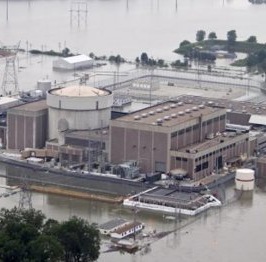
Read more...
|
|
 AFP, Feb 22, 2015 (emphasis added): Sensors at the Fukushima nuclear plant have detected a fresh leak of highly radioactive water into the sea… [with] contamination levels up to 70 times greater than the already-high radioactive status seen at the plant… TEPCO said its emergency inspections of tanks storing nuclear waste water did not find any additional abnormalities… It was not immediately clear what caused the original spike… “With emergency surveys of the plant and monitoring of other sensors, we have no reason to believe tanks storing radioactive waste water have leaked… We are currently monitoring the sensors”… The latest incident, one of several that have plagued the plant in recent months, reflects the difficulty in controlling and decommissioning the plant… TEPCO has not been able to effectively deal with an increasing amount of contaminated water…
AFP, Feb 22, 2015 (emphasis added): Sensors at the Fukushima nuclear plant have detected a fresh leak of highly radioactive water into the sea… [with] contamination levels up to 70 times greater than the already-high radioactive status seen at the plant… TEPCO said its emergency inspections of tanks storing nuclear waste water did not find any additional abnormalities… It was not immediately clear what caused the original spike… “With emergency surveys of the plant and monitoring of other sensors, we have no reason to believe tanks storing radioactive waste water have leaked… We are currently monitoring the sensors”… The latest incident, one of several that have plagued the plant in recent months, reflects the difficulty in controlling and decommissioning the plant… TEPCO has not been able to effectively deal with an increasing amount of contaminated water…


 about Nuclear
about Nuclear














